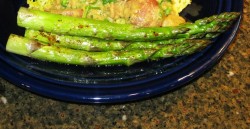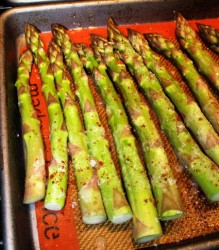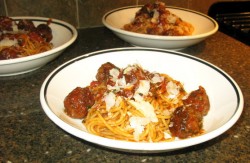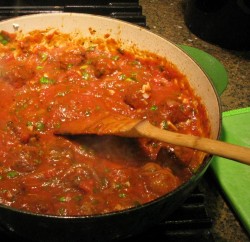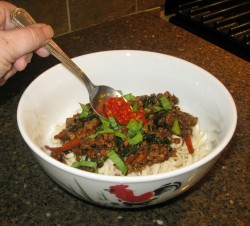Asparagus Roasted With Ghee and Garam Masala
Asparagus is one of my favorite seasonal spring foods, and I have cooked it many different ways. Sauteed, stir-fried, steamed, raw in a salad or simmered into a soup, I love it every which way. And I am always seeking new recipes for it–not because I am bored with it, but because I want to taste it as many different ways as possible. It is too fascinating to me how the texture and flavor of asparagus changes depending on which cooking technique is employed for me not to want to play with it when it is in season and plentiful.
Thus, every spring, I try to come up with at least two new variants for cooking asparagus.
I have to admit that while I love the flavor of roasted asparagus, I have not made it often.
Why, I am not certain, but there we are.
Last night, I decided to change all of that, in large part because I had picked up some really beautiful, organically grown fat green spears with delectably violet tips at the farmer’s market, and they were perfect, just perfect for roasting.
That is the way of it–the thick tender spears are best for roasting. The spindly thin spears which are fine blanched, steamed, stir-fried or sauteed, if roasted or grilled, will turn stringy and tough. But the juicier fat spears have enough moisture in them to withstand the high heat required to roast the asparagus to perfection.
Most recipes for roasting asparagus include an oil of some kind–usually olive oil, in order to keep the vegetable from drying out and to also enhance the natural flavor of the vegetable. When I decided I wanted to use garam masala with the asparagus, I could have used canola or peanut oil, but I decided to use melted ghee instead. The nutty, buttery richness of ghee would taste very well with the spice mixture, salt and Aleppo pepper flakes I was using to flavor the asparagus, while its richness would impart a certain velvety texture to the mouthfeel.
After the spears were done, I squeezed lemon juice liberally over them–the tart acidity of the juice balanced the rich ghee.
The asparagus turned out delicious–sweet and nutty, unctuous without being cloying and tender yet firm. It went perfectly with a curry and rice pillau for dinner last night. And the leftovers will be great in an omelet for tomorrow’s lunch.
Asparagus Roasted With Ghee and Garam Masala
Ingredients:
1 pound of thick (1/2″ thick, preferably) spears of asparagus, trimmed, rinsed and dried
2 tablespoons ghee,melted
1/8 teaspoon salt (or to taste)
1/4 teaspoon Aleppo pepper flakes
1/8 teaspoon ground garam masala
Juice of 1 lemon
Method:
Preheat oven to 400 degrees F.
Rub spears with ghee, coating each spear completely. Spread them out in a single layer on a non-stick baking sheet or one lined with a silpat. Sprinkle evenly with salt, pepper flakes and garam masala, and put the sheet in the oven.
Allow to roast for seven to ten minutes–or until the spears are fork-tender.
Just before serving, squeeze lemon juice over the spears.
My First Landscape Quilt
I got invited to display some of my quilts in a local exhibit starting on May 15. I wanted to make something completely new for it, and I had a lot of really beautiful hand-dyed fabrics, so I decided to make a landscape quilt.
The view on the quilt is inspired by bits and pieces of the scenery we saw in New Hampshire while we were there in the fall, although I chose to depict summer instead of fall. I used hand-dyes and batiks for the main fabric choices, but the leaves and the flowers in the foreground are cut from three different Japanese fabrics.
I didn’t like the colors of the leaves, so I hand-colored them with Prismacolor colored pencils, then heat-set the colors with an iron. I also used Shiva paintsticks to add iridescent snow to the mountain peaks, darker green in the foreground and some really lovely highlights on the water of the lake. These oil paints in solid form have to dry for there days, then they, too, can be heat-set to make them permanent. Today, I am going to heat set the oil paints and then sew on a border/frame. Then I can get the backing and batting together and start quilting it!
I’ll post pictures when it is finished!
A Seasonal Spring Comfort Food: Ramped-Up Spaghetti and Meatballs
I love me my ramps and green garlic.
All year long, I anticipate with gustatory delight the spring season which not only brings morels, asparagus, rhubarb and strawberries, but also pungent-sweet, spicy-hot ramps and green garlic. I use them in cooking just as I would scallions and garlic, but in even more copious amounts than usual for my aromatics. I love the overpowering aroma of these young, fresh vegetables, and when they are paired with cheese and tomatoes, as I did last year in Kiss Kiss Bang Bang Spaghetti, they are especially delectable.
This year, because for some reason I cannot fathom, I have been craving meats and cheese like a madwoman, even as I lose weight, I decided to make Kiss Kiss Bang Bang again, but this time, to add meatballs. I used parmesan cheese instead of goat feta, because I had that and not the other, and I used a teaspoon of bacon drippings instead of the butter to enrich the sauce. For the meatballs, I used the extremely lean, tender and beefy flavored locally produced ground bison from Dixon’s Elk Run Buffalo Farm. These were seasoned with plenty of minced ramps and green garlic, cumin, Aleppo pepper flakes and smoked Spanish paprika, and fried in olive oil, then simmered in red wine until they were nearly done, then they were added to the sauce, while the wine reduced to 1/3 of its original volume. The wine reduction was then added to the sauce, and the whole lot simmered for about fifteen minutes, until the sauce thickened and the meatballs were done perfectly.
One thing about bison meat–because it is so low in fat, you need to be careful how you cook it, in order to keep it from drying out. I use lower heat, and after the outside of the meat has browned, I use moist heat–this time in the form of wine–to keep it tender and succulent. You can also add a little bit of fat to it–in the form of olive oil, a tiny amount of bacon drippings or butter, or a little bit of egg yolk or mayonnaise–when you blend the seasoning ingredients into the ground meat. You don’t need much–just a small amount–and your meatballs will be juicy and flavorful, instead of dry and flubbery. About a teaspoon per pound will do. The added benefit of the fat is that it will help your very lean ground bison hold together when you cook it–it will lower the amount of binder you need to use to get the meat to cling to itself.
For binder, I used matzo meal, because that is what I had around and I like the texture it imparts to meatball mixtures. It makes them less dense than fresh breadcrumbs and it imparts no flavor of its own to the bison.
As for seasoning, I like the way cumin makes beef and bison taste–beefier. It synergizes with the meat and makes it taste even richer and more–meaty. I guess it probably boosts the umami flavor inherent in the bison. The smoked paprika adds a nice earthy touch and the ramps and green garlic–well, they speak for themselves. A little bit of salt is all the rest that you need.
And yes, you can tell by reading these last two posts that I ave been eating wheat, until and unless I am told otherwise. We will see what we will see when the tests come back. Until that time, I am going to enjoy food as much as I can, and that includes my beloved spaghetti and Chinese noodles, sauced in as many different ways as I can conceive.
Ramped Up Spaghetti and Meatballs
Ingredients:
1 recipe of Kiss Kiss Bang Bang–leave out the goat feta (or use it in place of the Parmesan, and if you want, replace the butter with a teaspoon of bacon drippings)
1 pound ground bison or beef (If you use the beef, do not use the added fat, which is next on the ingredient list)
1 teaspoon bacon drippings, mayonnaise, egg yolk (I use 1/2 a large egg yolk, or you can use 1/2 an egg instead), olive oil or butter
1/2 teaspoon ground cumin
1 teaspoon Aleppo pepper flakes
1/4 teaspoon salt
1/8 teaspoon smoked paprika
1/8 cup minced ramps and green garlic tops combined–or one or the other, if you prefer
1/4 cup matzo meal
2 tablespoons olive oil
1 cup soft red wine
1/4 cup shredded or shaved Parmesan cheese
1 pound spaghetti cooked al dente and drained well.
extra Parmesan for garnish.
Method:
Follow the instructions to make Kiss Kiss Bang Bang. While the sauce simmers on low heat, make the meatballs.
Mix together the bison, added fat of your choice, spices, ramps and/or green garlic, and the matzo meal. Mix together with your hands until it is completely blended. Roll into walnut-sized balls.
Heat olive oil in a frying pan until it is nice and hot. Add meatballs, and cook, shaking now and again until they are completely brown on the outside. Add the wine and cover, and allow to simmer and steam for about five to eight minutes. Uncover and transfer the meatballs to the Kiss Kiss Bang Bang sauce and allow the wine to reduce to 1/3 cup. Pour the combined wine and meat juices into the sauce with the meatballs, and stir to combine. Allow the sauce to thicken until it coats the back of a spoon, then toss with the spaghetti and the cheese. Garnish with extra cheese flakes or shreds, and serve in warmed bowls.
This will serve four adults and one toddler.
Pucca Noodles
Allright, before I tell you about these noodles I need to explain about Pucca.
Pucca is a South Korean cartoon featuring the unbearably cute main character, Pucca, (pictured over there–see her?) who is the daughter of the chef of a noodle restaurant in tiny Sooga Village. The animation is somewhat South Parkesque, with the kind of chase sequences that Chuck Jones made famous in his Roadrunner/Coyote cartoons. The humor is bizarre, physical and sometimes very potty–with lots and lots of pop culture references from Bruce Lee to Iron Chef to Sergio Leone.
The main thrust of the series is that Pucca is in love with Garu, who is a young ninja, and she is constantly chasing him around trying to steal kisses. That is about it–everything else flows from that premise.
It is a great deal of fun, and you can watch various episodes on You Tube–just look up Pucca and you will be in business.
Zak discovered Pucca somewhere on the Internet and then found and picked up a bunch of DVD’s of the television series, which is amazingly popular not only in Korea, but all over Asia and Europe. It is also very well loved in our house, especially with Kat and Zak. She has taken to playing at being either Pucca or Garu, wanting to chase or be chased depending on which role she will play. It is very cute–she runs around the house, saying, “Me Garu, me Garu!” which is the signal for one of us to say, “Pucca loves Garu,” and to chase her. The chase ends with kisses, giggles and tickles, and then starts again, and we do this over and over, through the dining room, down the hall, into the kitchen and back again.
As for the noodles–well, the restaurant where Pucca has grown up is famous for za jiang noodles–a traditional Chinese dish that is exceedingly popular in South Korea, so much so that the Korean variants are probably as well known as the original now. It consists of wheat noodles served with a meaty sauce of minced pork and fermented bean paste, garnished with blanched vegetables and herbs.
This version I am presenting here has mostly local ingredients–ramps gathered from the woods here in Athens county, bok choi by Green Edge Gardens, the last of the winter’s store of local carrots, honey from Athens, chicken broth from local chickens, garlic from last fall, local small farm pork, scallions and cilantro from down the road, and Rossi Pasta noodles from Marietta, Ohio. Only the Asian condiments are from elsewhere–fermented black beans, bean sauce, and Shao Hsing wine from China, and fermented bean paste from Korea. The ginger was from California, and the sesame oil is also Chinese. Oh, and I forgot, I garnished it with my very own chili garlic paste, that I made from my own Thai chilies.
A vegetarian version of this noodle dish using minced up mushrooms and tofu can be found here for those who prefer vegetables with their noodles, or those who do not have local, small farm pork available and who do not want to support CAFOs where pigs are kept in horrible conditions, conditions which may have contributed to the recent Swine flu epidemic in Mexico and the rest of the world. (You knew I had to mention that, didn’t you?)
Anyway, this is a delicious, quick supper that can be as spicy as you like, as diners can add more chili garlic sauce at the end to each individual noodle bowl in order to customize the flavor to their own palate. You can add more vegetables if you like–blanched bean sprouts would rule, as would shredded snow peas or napa cabbage. If you can eat shellfish, you could add minced dried shrimp or some fresh shrimp, cut in half longitudinally, and they would be delicious. In the summer, you could add halved fresh grape tomatoes, and I bet they would taste outstanding, as well as put some of Pucca’s signature color–red–into the dish.
So, I bet you are wondering how well did Kat and Zak like Pucca Noodles?
They loved them, which was not surprising to me. They both ate big bowls of them, and then Kat came and started begging for tidbits out of my bowl. The fermented bean pastes add a deep, umami flavor, redolent of the earth, while the fresh ramps, scallions and cilantro add notes of green garlicky, oniony goodness. These Chinese/Korean/Appalachian noodles are truly satisfying and soul-stirring for even the hardest of hearts and pickiest of appetites.
They liked them so much that even though we had them for dinner night before last, they asked for them for dinner again tonight!
Oh, and one more thing–you can serve this sauce with cooked and drained rice noodles if you like. I bet it would be good tossed with bean thread noodles, too.
Pucca Noodles
Ingredients:
2 tablespoons canola or peanut oil
1 teaspoon bacon drippings (optional)
2 bunches scallions, white part only, thinly sliced on the diagonal
2″ cube fresh ginger, peeled and minced
6 large cloves garlic, peeled and minced
2 tablespoons fermented black soybeans
1 pound ground pork
2 tablespoons Shao Hsing wine or dry sherry
2 tablespoons ground black bean sauce
1 1/2 tablespoons Korean fermented bean paste
1 teaspoon chili garlic sauce
2 1/2 tablespoons honey
1 cup chicken broth or vegetable broth
1 tablespoon cornstarch dissolved in 2 tablespoons of water or the broth
1 1/2 cups julienned carrots, blanched and cooled
2 cups bok choy cut into thin shreds
2 cups ramps, cut into thin shreds
1 cup roughly chopped cilantro leaves
1 teaspoon toasted sesame oil
1 pound flat Chinese wheat noodles, cooked al dente and drained, rinsed in cold water, then drained again
2 bunches scallions, green tops only, cut very thinly on the bias
1/2 cup thinly shredded ramp leaves
chili garlic sauce for garnish
Heat wok or heavy-bottomed skillet until smoking. Add oil and optional bacon drippings. (You can leave them out if you want, but if you have them, they add a deep smoky richness to the sauce.) Allow drippings to melt and oil to heat for a minute, then pour in the scallions, garlic, ginger and black beans, and cook, stirring, until everything is a nice golden color and is quite fragrant. Add the pork and using a chopping motion with your wok shovel or spatula, break up the meat while it browns. When it is browned, add the sherry, the bean sauce and paste, the chili garlic sauce and honey, and half of the chicken broth.
Cook for a minute, then add the cornstarch mixture and the rest of the broth and stir well to combine. The sauce should thicken almost immediately. At that point, add in the carrots, bok choy, ramps and roughly chopped cilantro leaves and stir until the bok choy wilts. Stir in sesame oil.
Divide noodles into four big bowls, top with the sauce then sprinkle with the scallion tops and the 1/2 cup of shredded ramp leaves. Add chili garlic sauce to the top as garnish or pass it around so everyone can help themselves and add as much as they would like.
Health Update: We Don’t Know Anything Yet
I want to thank everyone who left such supportive, loving comments on the last post I wrote. It is very uplifting to read them when I don’t feel well enough to bother writing.
I was hoping to know something to report by this time, but no, the blood tests have not come back yet. They also did additional blood work on Tuesday, checking me for thyroid dysfunction, (both hyperthyroidism and hypothyroidism run in my family on both sides) as well as arthritis and other stuff.
The doctor I saw on Tuesday, who is not my regular physician, but the one I could get in to see on short notice in the same practice because I suffered from a really bad day of chronic pain and bone-weariness on Friday, mentioned the possibility of fibromyalgia, which, probably not coincidentally, has been diagnosed in two of my female relatives, both of whom also have thyroid problems. Fibromyalgia is a chronic pain disorder that is related to Epstein-Barr, otherwise known as chronic fatigue syndrome. There are various theories as to what causes it, including some sort of dopamine malfunction in the body–and considering that my sleep disorder and depression have both been successfully treated with medications that either are dopamine reuptake inhibitors or artificial dopamine, I would not be surprised to know that dopamine had something to do with my chronic pain as well.
As for my digestion issues–apparently, irritable bowel syndrome goes along with fibromyalgia, so that may be what is going on, rather than celiac or wheat allergy/intolerance.
So, I am not going to change focus on Tigers & Strawberries quite yet–we will see what is going on before I go running off half-cocked and start changing my diet completely.
Once again–thank you all for your great comments–you are a wonderful bunch of folks.
Powered by WordPress. Graphics by Zak Kramer.
Design update by Daniel Trout.
Entries and comments feeds.

